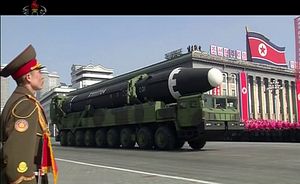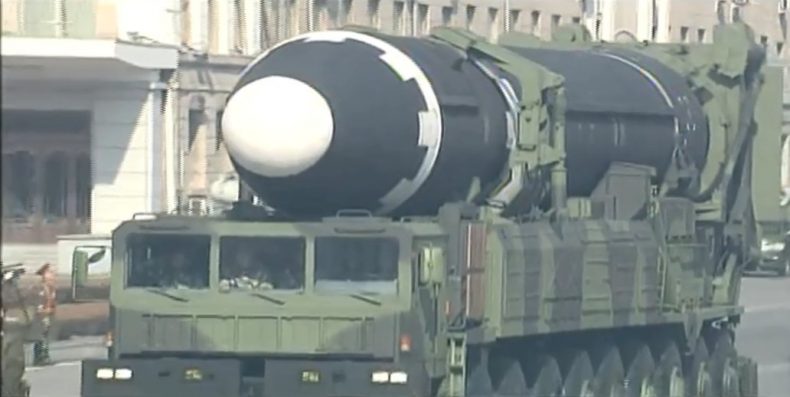On February 8, North Korea staged a military exercise in its capital, Pyongyang. The parade encompassed the usual array of units of the Korean People’s Army and, notably, included a crescendo to North Korea’s strategic rocket forces. While the parade fell considerably short of the 2017 “Day of the Sun” parade, which celebrated the country’s founder Kim Il-sung’s 105th birth anniversary, it did provide a useful set of new data and it even introduced an as-yet unknown missile to North Korea’s inventory.
The New Kid on the Block
Let’s begin with the new. As the ballistic missile portion of the parade began, North Korea introduced its first — and only — surprise for the parade. We saw a set of six transporter-erector-launchers (TELs) carrying two units each of what appeared, at least externally, to resemble a North Korean recreation of the Russian Iskander missile. (We also see programmatic similarities to some Chinese missiles, including the DF-12 here.) This missile has never been seen in a previous North Korean parade and may also be a long-rumored extended-range variant of North Korea’s Tochka (or KN02) close-range ballistic missile. According to the U.S. intelligence community, the original Tochka in North Korea’s missile inventory is said to have a range of around 120 kilometers.
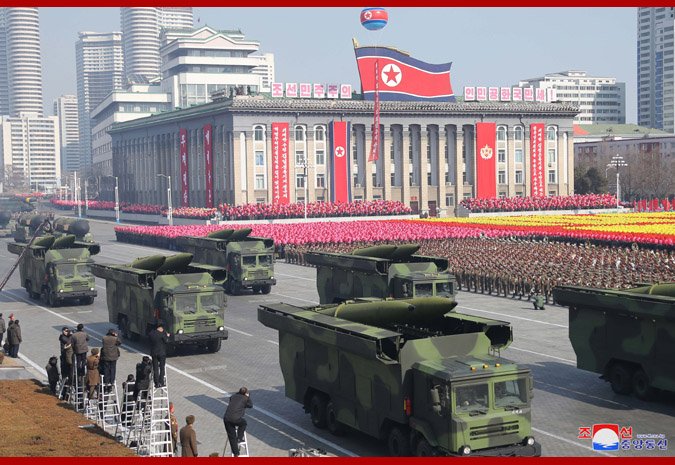
North Korea’s unidentified close- or short-range ballistic missile that bears external similarities to Russia’s Iskander missile. Source: KCNA
For now, there’s little else that can be said about this missile. We haven’t seen it flight-tested and, more likely than not, it probably won’t live up to the sort of accuracy the Iskander-class of Russian ballistic missiles are known for. For the North Korean program, a shorter-range solid-fuel ballistic missile does not seem too much of a stretch. North Korea, since at least 2014, has gained considerable experience in developing its own solid propellant engines and in casting its own solid propellants. One possibility is that the unexplained October 2017 solid propellant engine test near Hamhung was the engine for whatever this new missile might be. Recall too that North Korea has previously shown us untested ballistic missiles at parades; last year, for example, the KN18 Scud-C-variant appeared first at the April parade before seeing its first-ever flight-test in May.
Of course, while this missile resembles a Russian Iskander externally, there are important differences and until analysts can derive more precise measurements, this should be taken as a preliminary assessment that may not ultimately describe the missile’s provenance. None of this means that the North Koreans have been transferred Russian ballistic missile designs or technology; rather, the fact that the North Koreans chose to include a hinged TEL design with this new missile suggests that they may be purposefully trying to emulate the Iskander’s design elements. Until this missile is tested, there’s little more that can be said about its performance — most notably its accuracy and range.
We can, of course, offer informed speculation on the strategic use of a system like this one. Assuming a range capability below 1,000 km and moderate-to-high accuracy, this missile could give North Korea more of what its KN02 inventory offered: fairly robust conventional precision strike at military targets across the demilitarized zone in a conflict. It’s highly unlikely that this is a nuclear-capable system; North Korea likely intends to deliver conventional payloads with this missile, with a potential for chemical weapons delivery as well.
The Unsurprising
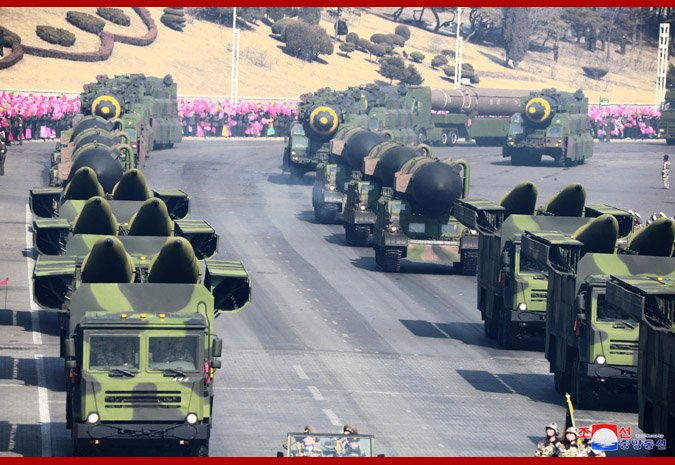
North Korea’s new, unidentified Iskander-like missile (foreground), followed by the Pukguksong-2 medium-range ballistic missile and the Hwasong-12 intermediate-range ballistic missile. Source: KCNA.
Following the new missile, we saw six launchers each of the Pukguksong-2/KN15 solid-fuel, medium-range ballistic missile — with its signature integrated tracked TEL — and the Hwasong-12/KN17 liquid-fuel, intermediate-range ballistic missile. There’s little to be said about these missiles; they’re the core of North Korea’s theater-wide nuclear strike capability, with the Hwasong-12 demonstrably ranging Guam ever since North Korean leader Kim Jong-un tested one of those missiles over Japan and into the northern Pacific Ocean last September, flying a total range in excess of that what would be required to strike the U.S. territory from North Korean soil. Everything from the number of units to the launcher designs shown at the parade was predictable; the Pukguksong-2 is thought by U.S. intelligence agencies to have entered mass production, as per Kim Jong-un’s May 2017 order.
The Hwasong-14 and Hwasong-15
This was the first North Korean military parade to feature two intercontinental-range ballistic missile designs (ICBMs). Both the Hwasong-14 and the Hwasong-15 ICBMs made a debut following their respective inaugural tests in 2017. Neither missile was present at the April 2017 parade and both missiles show a common design heritage, with their first stage boosters being based on what appears to be a North Korean variant of the Soviet-origin RD-250 heavy rocket booster (North Korea dubbed this the “March 18 revolution” engine).
To be clear, it wasn’t surprising that we saw these missiles at this parade. Kim Jong-un’s New Year’s Day exhortation that his country’s nuclear force was completed meant that he had to flaunt the crown jewels of his ballistic missile program: the only two missiles with sufficient range to deliver a thermonuclear weapon to the continental United States. (The Hwasong-15 can easily range the entirety of the United States.) What was especially interesting, as I suggested before the parade, was the number of launchers North Korea showed off at the parade.
Hwasong-15
As impressive as they might be, North Korea’s ICBMs won’t parade themselves. They need to be carried on heavy vehicles. At Thursday’s parade, we saw five heavy vehicles carrying the Hwasong-15 ICBM — four units for the parade, and one back-up. These vehicles were the very same China-sourced WS51200 logging trucks that were converted by North Korea into ICBM TELs after being imported under falsified export licenses. The United Nations Panel of Experts on North Korea, in 2013, said that North Korea imported six of these vehicles in 2013 and we have yet to see more than six of these kinds of vehicles together at a single parade.
For reasons I elaborated on last week, it would be incredibly significant if North Korea were to develop the indigenous capability to produce its own ICBM-ready TELs. So far, we haven’t seen that it has this capability. At best, North Korean engineers have demonstrated a capability to modify the WS51200 substantially. Last year, for instance, these were able to mount ICBM-sized canisters on at least four of their six WS51200 TELs, signaling a programmatic intent toward an eventual solid propellant ICBM resembling something like Russia’s Topol-M.
The four Hwasong-15 TELs we saw at Thursday’s parade were almost certainly further conversions from the canister-bearing ICBM TELs we saw last year. First and most noticeably, the Hwasong-15 TELs are nine-axle variants of the origin eight-axle WS51200. We’d first observed this during the November 2017 flight test. Moreover, where the original WS51200 trucks had a two-window cab, North Korea’s modifications for the canisterized variants last year necessitated a depressed cab. When North Korea reconverted these WS51200 TELs for the Hwasong-15, it restored parts of the cab, resulting in a three-windowed design. (We first saw a TEL using this design in November 2017, when North Korea first flight-tested the Hwasong-15 out of Pyongsong.)
Hwasong-14
The Hwasong-14 quickly faded from prominence once Kim Jong-un oversaw the first flight-test of the missile’s far more capable older sibling, the Hwasong-15. Nevertheless, the missile made a prominent appearance during Thursday’s parade. Instead of appearing on an integrated WS51200-derived TEL — the form we saw it in during its two flight-test appearances in early and late July, 2017 — the missile simply appeared on a display-bed trailer, pulled by a heavy truck, for its inaugural appearance in Kim Il-sung Square in Pyongyang.
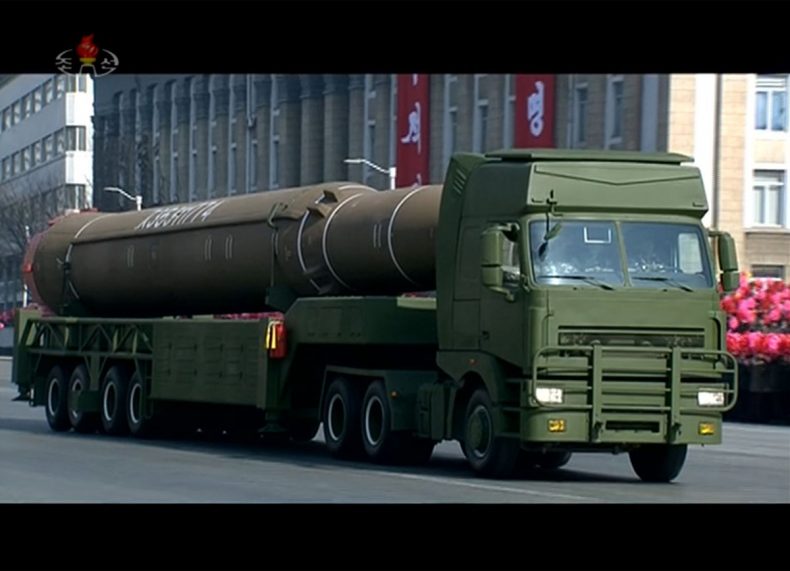
North Korea’s Hwasong-14 ICBM on a display-bed transporter during the February 2018 parade. Source: KCTV screen capture.
Attentive North Korea-watchers may recall that the trailer used for the Hwasong-14 this year wasn’t a novelty. In fact, last year, we saw North Korea trot out four units of an ICBM-sized canister on these very same trailers in a mobile-erector-launcher configuration — something akin to a juche-variant of the Chinese People’s Liberation Army Rocket Force’s (PLARF) DF-31A solid-fuel ICBM. (Interestingly, comparing this year’s footage with last year’s suggests that at least the Hwasong-14 and Hwasong-15 are much too large to fit into the canisters North Korea showed off in April.) That we didn’t see these Hwasong-14 ICBMs on launchers during Thursday’s parade suggests that North Korea remains somewhat constrained in its ability to field a large nuclear force by its number of ICBM launchers. We still have little evidence that Pyongyang has grown past its China-sourced WS51200 heavy trucks; while it can modify them to its satisfaction to accommodate the Hwasong-14, the Hwasong-15, and even last year’s Topol-M-resembling canister, it cannot yet put together its homebrewed variant in all likelihood.
All this is an inference from Thursday’s parade; there is a small chance that Kim Jong-un has operationalized other basing modes or built his own ICBM launchers and is simply choosing not to show this off at a parade. Given what we know about North Korea’s relative disinterest in transparency once its strategic systems are deployment or test-ready, it’s unlikely that Pyongyang is holding a launcher configuration or two up its sleeve. 2018 may yet be the year that we see a growth in North Korea’s launcher or basing configurations for ICBM. If Kim is indeed hard-bound by his existing inventory of WS51200 trucks, he may choose to invest in more creative basing modes, including silos, rail-mobility, and perhaps even something akin to the PLARF’s DF-4 ICBM launch protocol.
What We Didn’t See
While somewhat counterintuitive, what we didn’t see at Thursday’s parade is perhaps more noteworthy than what we did see.
North Korea has for years now built up a somewhat familiar nuclear force, comprising a range of Scud-variant ground-launched missiles — the Scud-B, Scud-C, and extended-range Scud; more recently, the KN18 Scud-C maneuverable reentry vehicle variant and the KN21 Scud-B maneuverable reentry vehicle variant — the Nodong medium-range ballistic missile; the Musudan intermediate-range ballistic missile; the Pukguksong-1 solid-fuel, submarine-launched ballistic missile (SLBM); and the yet-to-be-flight-tested Hwasong-13 mod 1 and Hwasong-13 mod 2 intercontinental-range ballistic missiles. The two latter missiles and the Musudan used the Soviet-origin 4D10 liquid propellant engine, a system North Korean engineers never appeared to quite master. (We also didn’t see the rumored Pukguksong-3 successor SLBM.)
None of the above systems were seen at Thursday’s parade. In the case of the two Hwasong-13 mods and the Musudan, it’s likely that they’ve been entirely set aside in favor of the RD-250-variant engine-based Hwasong-12, Hwasong-14, and Hwasong-15 missile set. The Pukguksong-1 was paraded last year and the Scud-variant missiles may already be deployed. Additionally, we can’t rule out that North Korea may have been somewhat fuel- and cost-constrained in the systems it chose to demonstrate during this parade. The incremental cost of reiterating that it had updated its Scud-C and Scud-B inventory was perhaps not worthwhile to Kim Jong-un given last year’s demonstration of the KN18 MaRV-variant Scud during the April parade.
The Bottom Line
Is there a big takeaway from Thursday’s parade? Yes, but not in the same way as the 2017 parade. In 2017, North Korea showed us that it was getting better at everything it was trying to accomplish with its nuclear forces. It also telegraphed its ambition for large solid-fueled, canisterized systems at the end of the parade to boot. In 2018, we saw mostly familiar strategic missiles — a “complete” nuclear force, Kim Jong-un would have us believe.
But, as I noted last week in these pages, the fact that North Korea did not incontrovertibly demonstrate an indigenous capability to manufacture full-fledged ICBM launchers should tell us something important. Kim probably is still contending with a manufacturing bottleneck and is unable to replicate the WS51200. He could probably move forward with a towed-trailer mobile-erector-launcher for both the Hwasong-15 and Hwasong-14, but remember that North Korea has limited paved roads.
An ICBM on a trailer would be less mobile overall than one on an integrated launcher, which would be more stable in day-to-day use. Assuming Kim does not intend to deceive by omitting homemade TELs from a parade, this limitation is still very real for North Korea. While this may be the case, I don’t expect North Korea to persist indefinitely with six ICBM launchers. We should either expect indigenous launcher designs or alternative basing modes soon. And remember, as North Korea’s launchers grow, its ability to more reliably overwhelm the already-questionable capabilities of U.S. homeland missile defense grow.
Beyond the launchers, perhaps the fundamental takeaway is that North Korea is consolidating what it sees as a “complete” first generation nuclear force around the RD-250-based Hwasong-12, Hwasong-14, and Hwasong-15 missiles — supplemented by its tried-and-true range of Scuds, Nodongs, and Pukguksongs. We should keep in mind that Kim Jong-un has yet to declare these new, long-range missiles operational and ready for deployment and mass production. That suggests that despite the ongoing Olympics-driven lull in inter-Korean ties, North Korean missile testing is more than likely to resume later in the year. We could see North Korea resume testing of its new missiles as soon as April, when the United States and South Korea will convene their annual springtime mass-mobilization military exercises.
Ankit Panda is a senior editor at The Diplomat, where he writes on security, politics, and economics in the Asia-Pacific region. He tweets at @nktpnd.













